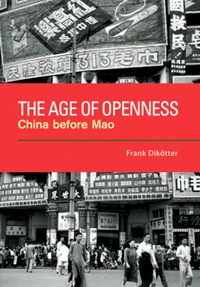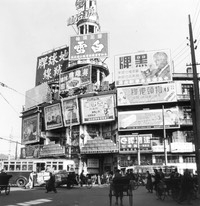Sir John Plumb, one of the great social historians of the eighteenth century, once said that bland consensus does not do much to advance historical knowledge, and consequently that there is little point in accumulating facts within agreed frameworks of explanation. When we turn to the history of modern China, one of the most pervasive approaches in popular and scholarly accounts written during the Cold War was to take revolution as the key to historical change, so much so that 'revolutionary China' and modern China were often synonymous. 'Opium Wars', 'Unequal Treaties' and 'Peasant Rebellions', seen from such a perspective, are harbingers of decline in the nineteenth century, but the heart of darkness lies between the Sino-Japanese War of 1895 and the Civil War of 1946-1949. An enfeebled Qing is unable to resist the 'carving up' of China by imperialist powers following its defeat in 1895, while a 'Boxer Rebellion' shakes the very foundations of the empire, which soon collapses into chaos. Conventional wisdom has it that after the fall of the Qing in 1911 a weak and corrupt central government dependent on foreign loans is quickly succeeded by a string of rival 'warlords' who bribe, coerce, plot and fight their way to power, as 'China disintegrates'. A measure of political unification, we were told, is achieved by the Nationalist Party (Guomindang) in 1927, but endemic corruption, inept policies, political dissension, continued warfare and economic depression only deepen the country's predicament, popular unrest and peasant immiseration fuelling the success of the Communist Party. Continuous encroachments by imperialist powers culminate in the country's occupation by Japan after 1937, followed by a full-scale war between the Nationalist Party and the Communist Party from 1946 to 1949. 'Liberation' at last closes a somber chapter in the history of the country, as unification by Mao Zedong brings to an end a long series of humiliations: 'China has Stood Up'.
Teleology held this approach together. Because so much of the history of the twentieth century seemed to have been about revolution, students tended to look for the 'causes', 'roots', 'stages' and 'origins' of communism. Revolution provided the key for deciding which facts were historically relevant and which were not, a grid through which a unitary understanding of modern China could be created. So entrenched was this approach that even the study of famine, which could potentially have contributed to a critical assessment of the republican era, was neglected: as Sugata Bose has suggested, 'historians of Vietnam and China tend to write more about rebellion and revolution: those of India about fatalism and famines'. 'Imperialism', 'warlords', 'corrupt officials', 'local tyrants', 'peasant immiseration' and 'social disintegration' used to be some of the categories through which historians tried to understand the republican era. As a result, we have a historiography rich on 'exploitation', counterbalanced only recently by work on charity; it is abundant on 'communism', even if work on democracy has steadily been growing; there are gangsters, warlords and prostitutes in abundance, and only gradually are we gaining new insights on polyglot diplomats, returned migrants and business women. And despite many rapid changes in the field of modern history, even today attempts to move away from the conventional wisdom can be met with disapproval: when Fu Zhengyuan devoted an entire book to autocratic politics in China but included four pages on the liberal traditions which appeared before the communist takeover, an otherwise sympathetic reviewer accused him of being 'one-sided' in overlooking the 'dark side' of republican China.
Although variations of this bleak image can still be found in popular accounts, many professional historians have for some time shown that there was far more to the republican era than mere chaos and warfare. Even John K. Fairbank, a proponent of the 'history as revolution' approach, described the period as a republic of paradoxes, as culture, for instance, flourished despite constant warfare. More recent historians such as Parks Coble, Sherman Cochran, William C. Kirby, Mary B. Rankin and Thomas Rawski - to name but a few - have immeasurably enriched our understanding of republican China, while many scholars from Taiwan and the PRC have been approaching the period in a very open way for almost twenty years. A remarkably diverse and cosmopolitan period is increasingly gaining recognition from historians working in fields as diverse as diplomacy and religion. Efforts to document modern China's overwhelming impulse to join the world and open up its borders, minds and markets have been mounting for some time, although we still lack an integrated account illustrating the sheer extent and depth of the country's openness before communism. This long essay uses a variety of primary sources and a highly informative body of secondary literature to challenge the view that modern China was mainly defined by 'warlords', 'imperialism' or 'disintegration': it suggests instead that in many respects it might very well be qualified as a golden age of engagement with the world. People, things and ideas moved in and out of the republican era, as global flows fostered an unprecedented degree of diversity which has yet to be appreciated in standard history textbooks: globalisation, rather than revolution, appears - with the benefit of hindsight - to have been the driving force of the half-century before the Cold War. The point of this essay is not to provide exhaustive evidence for this view, but to avoid bland consensus, provoke critical thought and encourage readers to think creatively: in many cases footnotes refer to detailed research monographs which offer much fuller arguments, while future avenues for research are opened up in all chapters.
Chapter Two indicates that even if the central government is often believed to have been weak in republican China, it displayed considerable elements of continuity in terms of political vision, administrative practice and government personnel. It also examines the growth of participatory politics and political diversity, from the electorate of 40 million in 1912 to the fully democratic constitution of 1947. It shows how the number of associations and organisations set up independently from the government, from chambers of commerce to beggar unions, increased drastically, and how well over a thousand dailies, weeklies or monthlies circulated already in the 1920s, often published in the treaty ports under the aegis of foreign extraterritoriality. We will see how sustained efforts at legal reform, which included sophisticated legal codification and widespread legal expertise, also contributed to a much more open environment, despite many abuses of judicial independence and judicial administration, which were openly noted and discussed by contemporary critics and government officials alike. Governance, in short, was far more open during the republican period than is usually accepted.
Chapter Three examines how individuals from all backgrounds, whether ordinary farmers or privileged students, were interested in the world beyond their community, while the opening of the borders led to growing movement of people in and out of the country. Some cultivated distinctly cosmopolitan lifestyles, whether it was the emigrant building a modern house on his return from decades of hard labour overseas, the student publishing in a foreign language after completing graduate work abroad or the diplomat who elected domicile in a foreign concession after years of service in Washington or Geneva. The flow went both ways, and many foreigners did not merely visit China, but made it their home: the second part of this chapter shows how foreign communities were part of the social texture of republican life and should be considered as an integral part of the social history of the country.
Chapter Four is the most important, and looks at the cultural and social aspects of China's cosmopolitan age. Open borders resulted not only in large flows of people moving in and out of the country, but also in active participation in international conferences and international covenants. Several bilingual lawyers became judges at the International Court of Justice in The Hague, while educated professionals were able to match their foreign peers in many other fields, ranging from avionics to zoology. Ordinary people too were often familiar with the world beyond their community, as illustrated magazines and radio programmes disseminated information about every aspect of the modern world, whether new agricultural techniques or the fluctuating price of silk on the international market. A global outlook was also promoted by the many modern schools which appeared after 1900, as even small establishments deep inside the hinterland introduced their students to the biographies of great foreign figures like Lincoln, Washington, Napoleon, Watt and Edison. Needless to say that a mere handful of students went on to pursue careers as consuls and ambassadors abroad, while only a fraction of the population was fully literate, but opportunities for education were more diverse than ever before, as government organisations, private societies and religious associations, funded by local elites, merchants guilds or foreign benefactors, contributed to the spread of new ideas. Religious expression was also allowed to thrive in a climate of relative tolerance, while culture bloomed in the absence of a monopoly on power and knowledge.
How about the economy? It is not the purpose of Chapter Five to review all the debates about economic growth in republican China, but merely to underline that economic activities were relatively unhindered in comparison to those closely monitored under imperial and communist regimes. Technological transfers were greatly facilitated by an open society at all levels, whether local workmen building truck bodies to fit imported engines in Beijing or the engineers instructed by Belgian specialists at a cloth-making industry established in distant Lanzhou even before the fall of the empire. The free flow of goods not only transformed the material culture of everyday life (one thinks of rubber galoshes and enamelled washbasins), as a huge range of goods appeared which would not be matched for decades under communism, but it also encouraged the appearance of highly diversified local industries plugged into a much larger global market. The economy was not 'stagnant' or 'regressing' from 1870 to 1930, but steadily growing and thriving, even in the countryside. Human enterprise may have been frustrated by civil war or local officials, but it proliferated even in the hinterland.
Communism and, ironically, nationalism have seen openness as a cause of decline in republican China. However, we now have the critical distance, the archival material and the secondary literature to question this view. While it is certainly true that not all regions benefited equally from the phenomenal changes described in this book, the image of a war-torn, enfeebled if not starving China which comes from the more deprived areas is very much the exception rather than the norm. Whether or not a poor republic is better than a mediocre dictatorship is open to debate, but the diversity of prerevolutionary China surely deserves due recognition. Now that globalisation, rather than 'revolution', has become the guiding issue for the present, from Latin America to India and China, the oft-forgotten cosmopolitan experience of the republican era is of even greater relevance.

